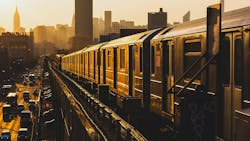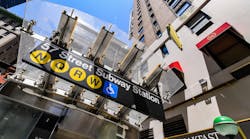New York City Comptroller releases new transit data, plan to better serve commuters post COVID-19
New transit data and a set of policy recommendations were released by New York City Comptroller Scott Stringer in response to decreased public transit ridership and an emerging need for reforms as the COVID-19 pandemic continues to impact the city’s workforce and commuting patterns.
Comptroller Stringer’s report, “Beyond Rush Hour: COVID-19 and the Future of Public Transit," highlights significant variations in subway ridership by borough, by time of day and by transit mode amid the pandemic. Comptroller Stringer outlines a variety of recommendations to address new and existing changes to the city’s public transit system in a post-COVID landscape: implement six-minute subway and high-ridership bus service throughout the day to better serve the city’s growing legions of shift workers; flip the state gas tax within the 12-county Metropolitan Commuting Transit District so that the lion’s share of funding goes to support public transit, not roads and bridges; open up the vast commuter rail network within the five boroughs; create 60 miles of dedicated bus lanes and busways; increase affordable housing production near existing stations; meet the transit service needs of women, parents and caregivers; reopen closed subway station entrances; and pass the Commute Trip Reduction law so that employers incentivize public transit commuting among the workforce.
Comptroller Stringer’s report reveals transportation discrepancies among blue-collar workers and white-collar workers, with the former using public transportation to travel to in-person jobs more often than the latter.
- 61 percent of jobs in shift work or service industries that do not abide by the typical nine to five workday—like food, accommodations, healthcare, retail, building and personal services—are located outside of Manhattan.
- 89 percent of jobs that are well suited for remote and hybrid work—including finance, insurance, tech, media and other professional service—are located in Manhattan.
“The data is clear. The new rush hour is around the clock—and we need to reform our outdated transit system to meet people when and where they are in a post-pandemic economy,” said Comptroller Stringer. “Frontline workers and New Yorkers in face-to-face jobs can’t afford to wait endlessly at platforms and bus stops for trains and buses that never come. If we want to reduce congestion and encourage people return to public transit, we need to invest in changes that make public transit an accessible and convenient option for every commuter at every time of day.”
Comptroller Stringer’s report outlines key data points that support the need to better align public transit with today’s economy. The results of these changes have left the city’s transit system with unresolved challenges—namely declining farebox revenues and service that does not benefit ridership that is disproportionately lower income, living and working outside of Manhattan, likely to work in face-to-face industries and more dependent on off-peak subway and bus service.
From 2019 to 2020, farebox revenue dropped by $2.9 billion while traffic congestion swelled up city streets.
Currently, typical subway ridership is 50 percent below pre-pandemic levels and bus ridership is down 40 percent– but there are variations by borough and time of day and week:
- Subway ridership was down 66 percent and bus ridership down 52 percent in Manhattan from 2019 to 2020; the respective numbers in the Bronx decreased by a modest 53 percent and 37 percent.
- Decreases in subway and bus ridership were noticeably smaller in the early morning, when many essential workers have to get to work. While subway ridership was down 62 percent in 2020 and bus ridership down 44 percent, in the early morning hours (5:00 a.m. to 7:00 a.m.), subway ridership fell by a more modest 48 percent and bus ridership by 32 percent.
- Meanwhile, weekend ridership has recovered at a faster rate than weekday ridership. As of September 2021, weekend subway ridership reached 65 percent of pre-pandemic levels, while weekday ridership hovered at an anemic 51 percent.
Eight policy recommendations to better serve riders
To better serve transit riders throughout the five boroughs, Comptroller Stringer’s report outlines the following policy recommendations.
1. Engage employers to incentivize sustainable commuting among their workforces
New York should follow the lead of Washington State and encourage employers to subsidize public transportation expenses for their workforce. To this end, the state should pass the Commute Trip Reduction law, requiring all worksites with 100 or more employees to survey employees, submit a biennial commute trip reduction plan and incentivize commuting trips via bus, train, biking, bikeshare and other sustainable modes. Special emphasis should be paid to hospitals, hotels and other large employers outside of Manhattan to encourage them to provide monthly MetroCards and Citi Bike memberships for their employees. To assist and participate in these efforts, the city should create an inter-agency task force designed to reduce car dependency within New York City and increase public transit ridership.
2. Rebalance and increase the gas tax within the 12-county Metropolitan Commuting Transit District to better fund public transit
Currently, only about a third of its proceeds go to public transit, while the rest is poured into maintaining roads, bridges and outdated highways. Now is the time for the state to reform its gas taxes to help pay for future transit improvements. Within the 12 county “metropolitan commuter transportation district,” gas taxes should be rebalanced so that roughly two-thirds of the revenue is devoted to public transit.
3. Implement the “New York City in Six” service plan, so that all subway routes and high-ridership bus routes arrive at least every six minutes throughout the day, seven days a week
The MTA should increase subway, bus and commuter rail frequencies to ensure adequate social distancing and align with the largely off-peak, non-Manhattan commuting patterns of those who cannot work remotely. Each subway line and the 100 highest ridership bus routes should run at a minimum of every six minutes throughout the day, seven days a week.
4. Congress should pass the “Stronger Communities through Better Transit” Act
The federal government should step up and support subway, bus and commuter rail service throughout the country – especially as farebox revenues fall and deficits soar. This is not the time to allow transit service to decline and leave nurses, grocery store clerks, waiters, janitors and security guards waiting in the cold for buses and trains that rarely arrive. Instead, Congress must pass the Stronger Communities through Better Transit Act, providing direct grants for public transit operating expenses.
As it stands, federal transit agencies are largely restricted to capital funding and grants cannot be used towards more frequent and reliable transit service. The funding allotted through the Stronger Communities through Better Transit Act would provide approximately $3 billion to the MTA each year and cover anticipated farebox losses in the coming years.
5. Stop squandering the vast commuter rail network
With suburban, white collar commuters likely to work from home for the immediate future, there is a distinct opportunity to open up the 41 Metro-North and LIRR stations located within the five boroughs. Moving forward, the fare for all in-city trips should be reduced to the price of a MetroCard and transfers between commuter rail, subway and bus should be free. Free transfers should also be extended to suburban commuters and trains should run at a minimum of every 15 minutes all day, every day.
6. Add 35 miles of dedicated bus lanes and busways each year
The Department of Transportation should add 35 miles of bus-only corridors and dedicated, protected bus lanes each year to reduce crowding and alleviate pressure on the subway system. This can be quickly achieved by targeting one-way avenues in Manhattan and throughout the five boroughs and converting them to two-way travel with one avenue set aside for car traffic and the parallel avenue exclusive for buses and bikes.
7. Improve transit access by increasing affordable housing production near existing stations and expanding the subway system
First, the city should rezone and subsidize the development of deeply affordable housing around subway stations in residential areas with less than 5,000 daily riders to maximize access to the subway for those who cannot work from home. This can simultaneously address New York City’s twin challenges of affordable housing and rail access.
Second, extending the subway down Utica Avenue in Brooklyn and rebuilding the Nostrand Junction should also be a longer-term priority to improve connectivity for working New Yorkers and communities of color outside of Manhattan.
8. Reopen closed subway station entrances to improve access and speed up commute times
Out of the MTA’s 468 subway stations, more than 100 have at least one street-level entrance that has been permanently closed. More than 60 percent of these stations are located outside of Manhattan, restricting public transit access beyond Manhattan. The MTA should create a five-year plan to reopen all of these entrances by 2027, which will speed up access to subway platforms for thousands of New Yorkers and shorten their daily commutes.
The full report is available on the comptroller's website.




